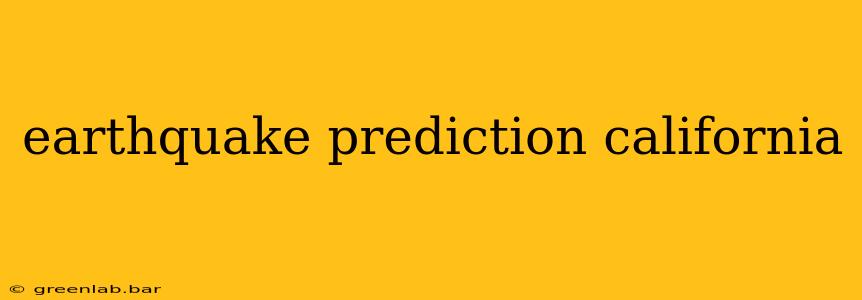California, situated along the infamous San Andreas Fault, is no stranger to earthquakes. The state's seismic activity is a constant reminder of the immense power of tectonic plates and the ever-present risk of significant tremors. While predicting the exact time, location, and magnitude of an earthquake remains elusive, significant strides are being made in understanding earthquake processes and improving our ability to assess and mitigate risk. This article explores the current state of earthquake prediction in California, highlighting the challenges, recent advancements, and the path forward.
The Challenges of Earthquake Prediction
Predicting earthquakes is a complex scientific endeavor. Unlike weather forecasting, which relies on observable atmospheric changes, earthquake prediction faces fundamental hurdles:
-
Complexity of Fault Systems: The Earth's crust is a complex network of faults, each with its unique characteristics. Understanding the interactions between these faults and the build-up of stress is crucial but incredibly difficult.
-
Lack of a Definitive Precursor: While scientists are actively searching for reliable precursors—signals preceding an earthquake—no single, universally accepted indicator has been definitively identified. Changes in groundwater levels, gas emissions, or animal behavior have been observed before some earthquakes, but these phenomena are not consistently reliable.
-
Data Limitations: Accurate and comprehensive data collection is essential for understanding earthquake processes. While seismographic networks provide valuable data on past seismic activity, the sheer scale and complexity of fault systems require extensive and continuous monitoring.
-
Statistical Challenges: Earthquake occurrences are governed by complex probabilistic models. While statistical methods can assess the likelihood of earthquakes in specific regions, pinpointing the exact timing remains an insurmountable challenge with current technology.
Progress in Earthquake Science and Monitoring
Despite the challenges, substantial progress is being made in various areas:
-
Advanced Seismology: Sophisticated seismic monitoring networks provide real-time data on ground motion, allowing for rapid assessment of earthquake magnitude and location. This data improves earthquake early warning systems, providing crucial seconds of warning before strong shaking arrives.
-
Geodetic Measurements: GPS and other geodetic techniques precisely measure ground deformation, helping scientists monitor fault movements and stress accumulation. This data contributes to improved hazard assessments and understanding of fault behavior.
-
Paleoseismology: By studying geological records, scientists can reconstruct past earthquakes, gaining insights into recurrence intervals and magnitudes. This information is crucial for long-term risk assessments.
-
Improved Modeling: Advanced computer models are being developed to simulate earthquake processes, incorporating data from various sources. These models are gradually improving our understanding of stress build-up, fault rupture, and ground shaking.
Earthquake Early Warning Systems in California
California's earthquake early warning system, ShakeAlert, is a significant advancement. This system utilizes real-time seismic data to provide seconds to tens of seconds of warning before strong shaking arrives, enabling individuals and infrastructure to take protective measures. While not a prediction system, ShakeAlert is a valuable tool for mitigating earthquake impacts.
The Future of Earthquake Prediction in California
The quest for accurate earthquake prediction continues. While predicting the exact time of a major earthquake remains a significant challenge, ongoing research and technological advancements hold promise for:
-
Enhanced Monitoring Networks: Expanding and improving monitoring networks, integrating diverse data sources, and employing advanced analytical techniques will enhance our understanding of earthquake processes.
-
Artificial Intelligence and Machine Learning: AI and machine learning algorithms are being applied to analyze large datasets, potentially revealing patterns and precursors that may have been previously overlooked.
-
Improved Hazard Assessments: By integrating data from diverse sources, scientists can refine hazard assessments, providing more precise estimates of earthquake probabilities for specific regions.
-
Community Preparedness: While precise prediction remains elusive, increasing community preparedness through education, building codes, and emergency response planning remains crucial.
Conclusion: While predicting the precise time and location of future California earthquakes remains an unsolved scientific problem, significant progress is continuously being made in understanding earthquake processes, improving monitoring capabilities, and enhancing early warning systems. Focusing on preparedness and mitigating the impacts of inevitable earthquakes remains the most effective strategy for safeguarding lives and infrastructure.

